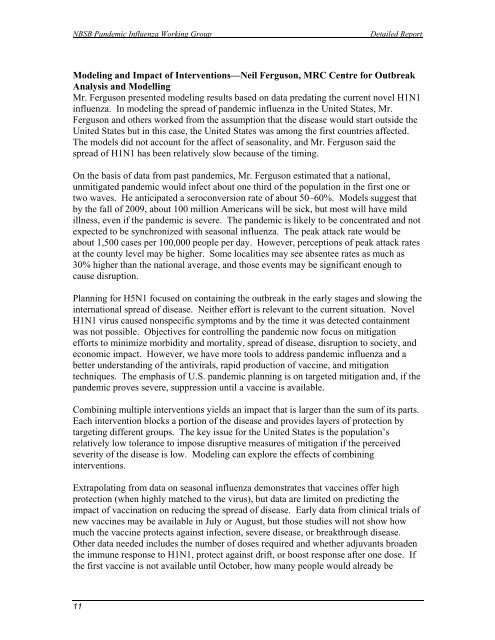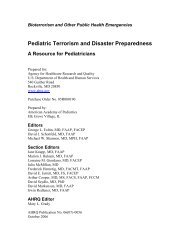H1N1 COUNTERMEASURES STRATEGY AND ... - PHE Home
H1N1 COUNTERMEASURES STRATEGY AND ... - PHE Home
H1N1 COUNTERMEASURES STRATEGY AND ... - PHE Home
You also want an ePaper? Increase the reach of your titles
YUMPU automatically turns print PDFs into web optimized ePapers that Google loves.
NBSB Pandemic Influenza Working Group<br />
Detailed Report<br />
Modeling and Impact of Interventions—Neil Ferguson, MRC Centre for Outbreak<br />
Analysis and Modelling<br />
Mr. Ferguson presented modeling results based on data predating the current novel <strong>H1N1</strong><br />
influenza. In modeling the spread of pandemic influenza in the United States, Mr.<br />
Ferguson and others worked from the assumption that the disease would start outside the<br />
United States but in this case, the United States was among the first countries affected.<br />
The models did not account for the affect of seasonality, and Mr. Ferguson said the<br />
spread of <strong>H1N1</strong> has been relatively slow because of the timing.<br />
On the basis of data from past pandemics, Mr. Ferguson estimated that a national,<br />
unmitigated pandemic would infect about one third of the population in the first one or<br />
two waves. He anticipated a seroconversion rate of about 50–60%. Models suggest that<br />
by the fall of 2009, about 100 million Americans will be sick, but most will have mild<br />
illness, even if the pandemic is severe. The pandemic is likely to be concentrated and not<br />
expected to be synchronized with seasonal influenza. The peak attack rate would be<br />
about 1,500 cases per 100,000 people per day. However, perceptions of peak attack rates<br />
at the county level may be higher. Some localities may see absentee rates as much as<br />
30% higher than the national average, and those events may be significant enough to<br />
cause disruption.<br />
Planning for H5N1 focused on containing the outbreak in the early stages and slowing the<br />
international spread of disease. Neither effort is relevant to the current situation. Novel<br />
<strong>H1N1</strong> virus caused nonspecific symptoms and by the time it was detected containment<br />
was not possible. Objectives for controlling the pandemic now focus on mitigation<br />
efforts to minimize morbidity and mortality, spread of disease, disruption to society, and<br />
economic impact. However, we have more tools to address pandemic influenza and a<br />
better understanding of the antivirals, rapid production of vaccine, and mitigation<br />
techniques. The emphasis of U.S. pandemic planning is on targeted mitigation and, if the<br />
pandemic proves severe, suppression until a vaccine is available.<br />
Combining multiple interventions yields an impact that is larger than the sum of its parts.<br />
Each intervention blocks a portion of the disease and provides layers of protection by<br />
targeting different groups. The key issue for the United States is the population’s<br />
relatively low tolerance to impose disruptive measures of mitigation if the perceived<br />
severity of the disease is low. Modeling can explore the effects of combining<br />
interventions.<br />
Extrapolating from data on seasonal influenza demonstrates that vaccines offer high<br />
protection (when highly matched to the virus), but data are limited on predicting the<br />
impact of vaccination on reducing the spread of disease. Early data from clinical trials of<br />
new vaccines may be available in July or August, but those studies will not show how<br />
much the vaccine protects against infection, severe disease, or breakthrough disease.<br />
Other data needed includes the number of doses required and whether adjuvants broaden<br />
the immune response to <strong>H1N1</strong>, protect against drift, or boost response after one dose. If<br />
the first vaccine is not available until October, how many people would already be<br />
11
















